Deepfake AI Market Size 2025-2029
The deepfake AI market size is valued to increase by USD 3.24 billion, at a CAGR of 40.8% from 2024 to 2029. Escalating demand in media and entertainment for hyper-personalized content and production efficiency will drive the deepfake ai market.
Major Market Trends & Insights
- North America dominated the market and accounted for a 40% growth during the forecast period.
- By Deployment - Cloud segment was valued at USD 99.60 billion in 2023
- By Technology - GANs segment accounted for the largest market revenue share in 2023
Market Size & Forecast
- Market Opportunities: USD 2.00 million
- Market Future Opportunities: USD 3238.10 million
- CAGR from 2024 to 2029 : 40.8%
Market Summary
- The market is experiencing unprecedented growth, fueled by escalating demand in media and entertainment for hyper-personalized content and production efficiency. This sector, valued at USD63.1 billion in 2020, is poised for significant expansion as synthetic media content creation becomes increasingly mainstream. Deep learning models and generative adversarial networks are used for image and audio synthesis, while facial recognition technology and biometric authentication systems ensure data privacy. However, the market's trajectory is not without challenges. Intensifying regulatory scrutiny and pervasive ethical dilemmas surrounding deepfake technology's misuse threaten to hinder its progress.
- As businesses navigate these complexities, they must prioritize transparency, ethical practices, and compliance with evolving regulations. The market's future direction lies in striking a balance between innovation and responsibility, ensuring that this transformative technology delivers value without compromising trust and authenticity.
What will be the Size of the Deepfake AI Market during the forecast period?
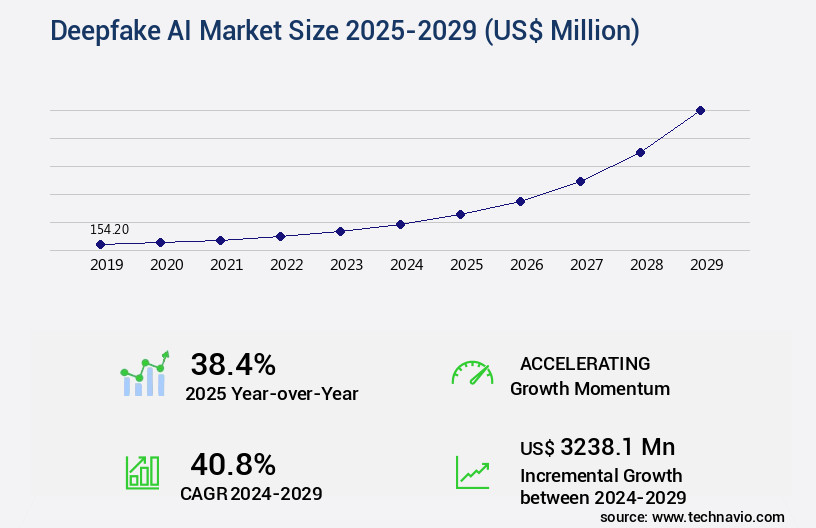
Get Key Insights on Market Forecast (PDF) Request Free Sample
How is the Deepfake AI Market Segmented ?
The deepfake AI industry research report provides comprehensive data (region-wise segment analysis), with forecasts and estimates in "USD million" for the period 2025-2029, as well as historical data from 2019-2023 for the following segments.
- Deployment
- Technology
- GANs
- Transformer models
- Autoencoders
- Recurrent neural networks
- Others
- End-user
- Media and production studios
- Enterprises and corporates
- Defense and intelligence agencies
- Education providers
- Others
- Geography
- North America
- Europe
- APAC
- China
- India
- Japan
- South Korea
- South America
- Rest of World (ROW)
By Deployment Insights
The cloud segment is estimated to witness significant growth during the forecast period.
The market continues to evolve at an unprecedented pace, with the cloud-based deployment segment leading the charge. This segment's dominance is driven by its scalability, accessibility, and cost-effectiveness, making it the preferred choice for a wide range of users, from individual creators and startups to large media and technology enterprises. In a cloud-based model, deepfake generation and detection services are hosted on the infrastructure of major cloud providers like Amazon Web Services (AWS), Google Cloud Platform (GCP), and Microsoft Azure. Users can access these capabilities on demand, typically through a web interface or an API, without the need for specialized hardware.
Deepfake technology's advancements have raised significant ethical concerns, necessitating the development of synthetic media detection solutions. These include blockchain-based verification, AI-generated content detection, and deepfake detection software. Machine learning classifiers, anomaly detection systems, and neural network architectures are employed to analyze data using statistical analysis methods, pattern recognition techniques, and temporal consistency analysis. Despite these advancements, deepfakes continue to pose a threat, with misinformation campaigns using video manipulation techniques and image quality assessment methods to deceive audiences.
To combat this, researchers are exploring data augmentation strategies, audio synthesis methods, and natural language processing techniques. Additionally, liveness detection systems and deep learning models are being used to identify video compression artifacts and forgery detection algorithms to analyze facial landmarks. The global deepfake detection market is projected to grow at a compound annual growth rate (CAGR) of 35.2% between 2021 and 2028, underscoring the urgency of these efforts.
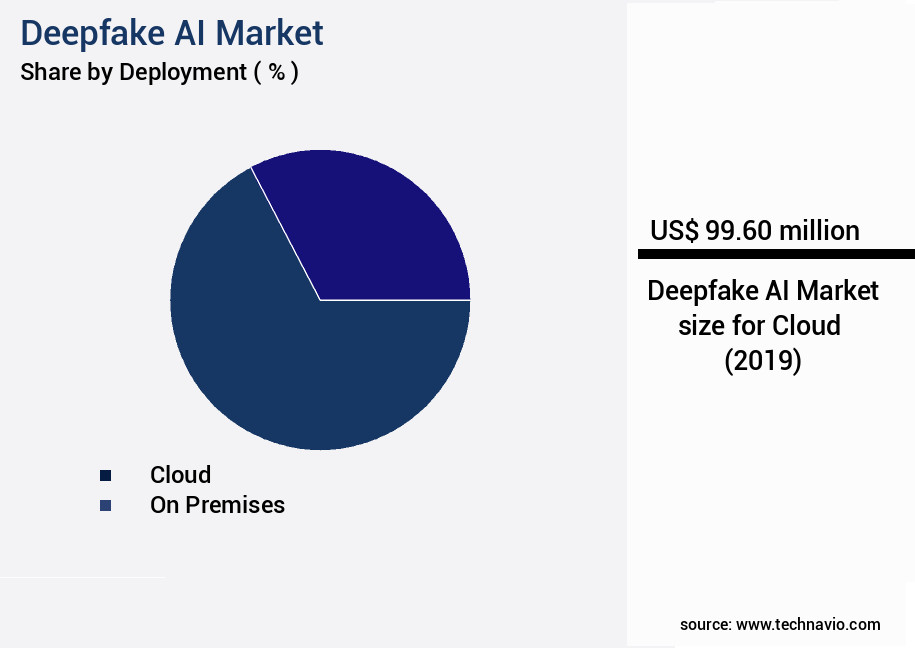
Request Free Sample
The Cloud segment was valued at USD 99.60 billion in 2019 and showed a gradual increase during the forecast period.
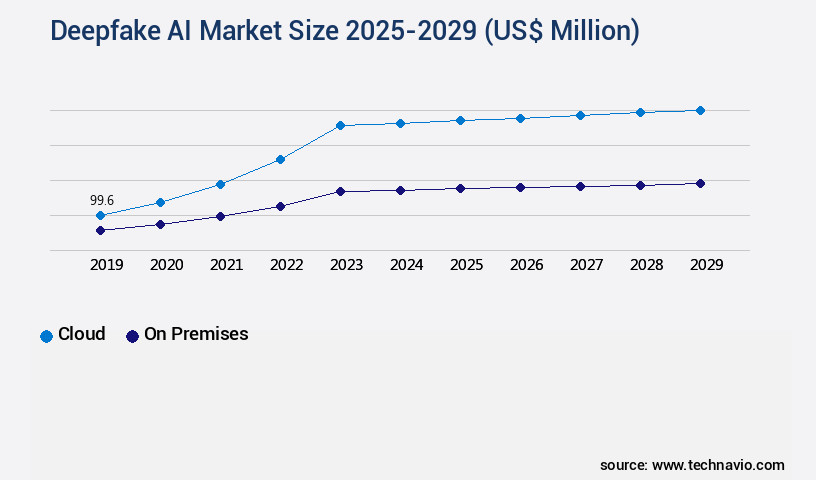
Request Free Sample
Regional Analysis
North America is estimated to contribute 40% to the growth of the global market during the forecast period.Technavio's analysts have elaborately explained the regional trends and drivers that shape the market during the forecast period.
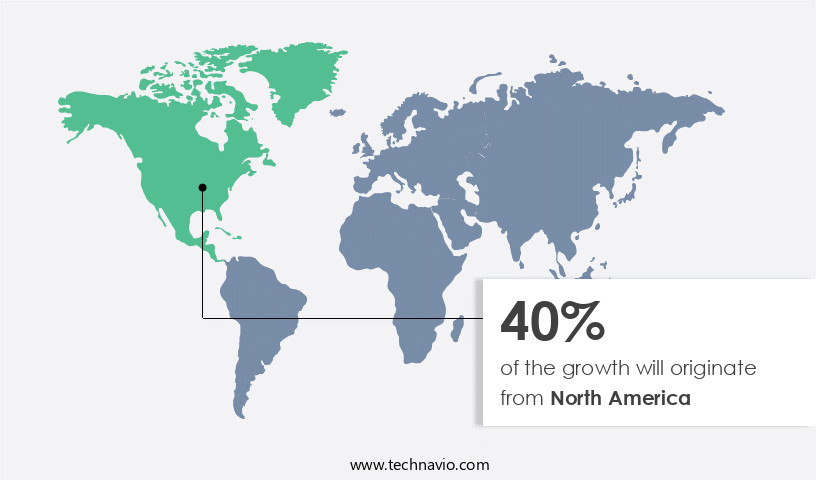
See How Deepfake AI Market Demand is Rising in North America Request Free Sample
The market is witnessing significant advancements, with the North American region leading the charge. The United States, in particular, is at the forefront of this technological evolution, driven by its concentration of artificial intelligence research institutions, semiconductor giants, and major technology corporations. This region's market maturity is reflected in the rapid development and deployment of deepfake technologies across various sectors, including entertainment, media, and corporate training. However, this market dominance brings about intricate challenges related to ethics, security, and political integrity.
Consequently, regulatory and corporate responses are underway to address these complexities. According to recent studies, the North American the market is expected to grow at an impressive pace, surpassing the European and Asian markets in terms of innovation and investment. Furthermore, the market's potential applications extend beyond entertainment and media, with significant opportunities in industries such as healthcare, education, and finance.
Market Dynamics
Our researchers analyzed the data with 2024 as the base year, along with the key drivers, trends, and challenges. A holistic analysis of drivers will help companies refine their marketing strategies to gain a competitive advantage.
The market is experiencing rapid growth as generative models for synthetic media creation gain popularity. Deep learning architectures for deepfake detection are becoming increasingly important to mitigate the ethical implications of deepfake technology. Advanced video analysis for deepfake identification is a key component of real-time deepfake detection using edge computing. Accuracy in deepfake detection is crucial, and data augmentation is being used to improve it. Biometric authentication systems are also being developed to counteract deepfake attacks. Blockchain technology is being explored for verifiable media authentication, adding an additional layer of security. Advanced algorithms are being developed to detect subtle deepfake artifacts, and a comparison of deepfake detection methods and performance is ongoing. Countermeasures to prevent the malicious use of deepfakes include the development of robust deepfake detection software solutions.
The impact of deepfakes on public trust and social interactions is significant, and regulatory frameworks are being established to control their spread. Innovative technologies for synthetic media verification are being researched to combat disinformation campaigns. Privacy and security considerations are essential in deepfake detection systems, and assessing the effectiveness of deepfake detection techniques is a continuous process. Ethical considerations and mitigation strategies are also being discussed in depth. Future trends and research directions in deepfake technology include the development of more advanced generative models and deepfake detection algorithms. The challenges and opportunities in addressing deepfake technology are vast, and ongoing research is necessary to stay ahead of the curve.
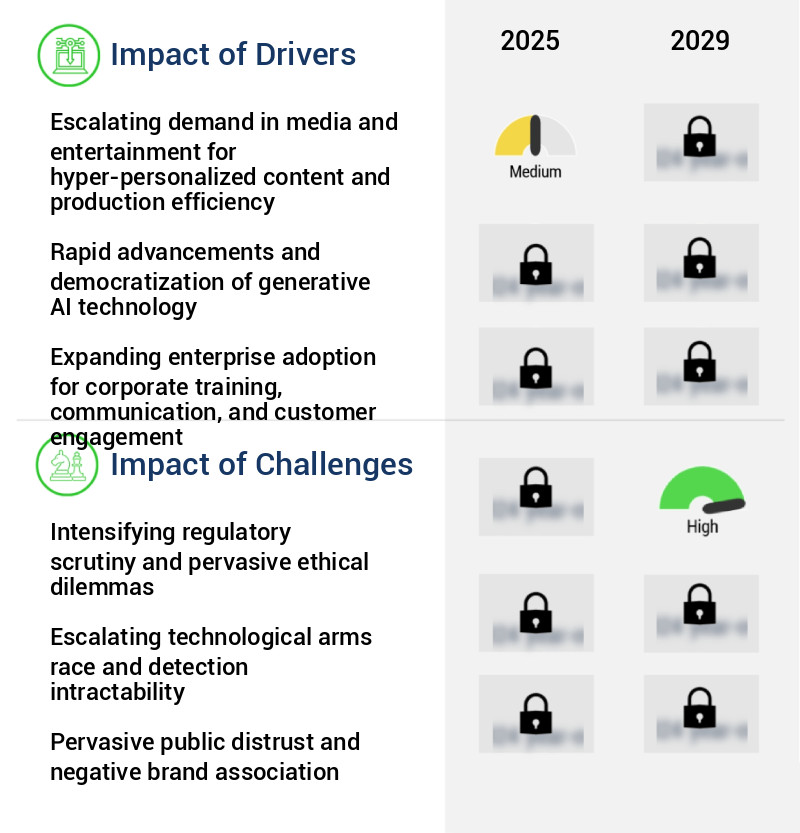
What are the key market drivers leading to the rise in the adoption of Deepfake AI Industry?
- The escalating demand for hyper-personalized content and production efficiency in the media and entertainment industry is the primary market driver, necessitating advanced solutions to meet these demands professionally and effectively.
- The market is experiencing significant growth and transformation, primarily driven by its increasing utilization in the media and entertainment sector. This industry, known for its constant pursuit of innovation and efficiency, employs deepfake technology to deliver two primary strategic benefits: generating hyper-personalized and unique audience experiences, and substantially reducing production expenses and timelines. Deepfake technology is evolving from a specialized visual effect to a fundamental production asset.
- Leading North American players, including Hollywood studios and streaming platforms, are pioneering this integration. They are investigating synthetic media for applications ranging from digitally rejuvenating actors to producing entirely virtual human performers. This innovation eliminates the logistical and financial challenges of securing top talent, coordinating intricate shoots, or recreating historical figures.
What are the market trends shaping the Deepfake AI Industry?
- The trend in content creation is shifting towards mainstream adoption of synthetic media. Synthetic media, such as computer-generated imagery and deepfakes, is becoming increasingly popular.
- The market is undergoing a significant transformation, moving beyond its niche applications and malicious uses towards becoming a mainstream tool in various sectors. This shift is evident in the media and entertainment industries, where generative AI is increasingly being adopted for synthetic media production. This trend is revolutionizing content creation, enabling hyper-realistic special effects and cost-efficient production models. The technology has advanced beyond simple face-swapping to encompass full-scale video generation, realistic voice cloning, and digital avatar development. These capabilities make deepfake AI an essential asset for filmmakers, advertisers, and content creators.
- The market's expansion in this area is fueled by the convergence of hyper-realism and cost efficiency. Deepfake AI's applications are not limited to media and entertainment; it is also being explored in sectors like education, healthcare, and finance for diverse purposes.
What challenges does the Deepfake AI Industry face during its growth?
- The industry faces significant challenges from increasing regulatory scrutiny and complex ethical dilemmas, which pose substantial hurdles to growth.
- The market is experiencing a significant evolution, marked by ethical dilemmas and a complex regulatory landscape. Deepfake technology, with its dual use potential, straddles the line between beneficial applications and potential societal harm. This ambiguity has resulted in heightened scrutiny from governments and regulatory bodies worldwide. The consequences of misuse, such as creating nonconsensual pornography, executing financial fraud, and disseminating political disinformation, have spurred a global legislative response.
- However, the approaches to regulating deepfake technology vary substantially across key regions like North America, Europe, and the Asia Pacific. This fragmented regulatory landscape poses a significant challenge for businesses, necessitating a nuanced understanding of the evolving regulatory landscape and a commitment to ethical business practices.
Exclusive Technavio Analysis on Customer Landscape
The deepfake ai market forecasting report includes the adoption lifecycle of the market, covering from the innovator's stage to the laggard's stage. It focuses on adoption rates in different regions based on penetration. Furthermore, the deepfake ai market report also includes key purchase criteria and drivers of price sensitivity to help companies evaluate and develop their market growth analysis strategies.
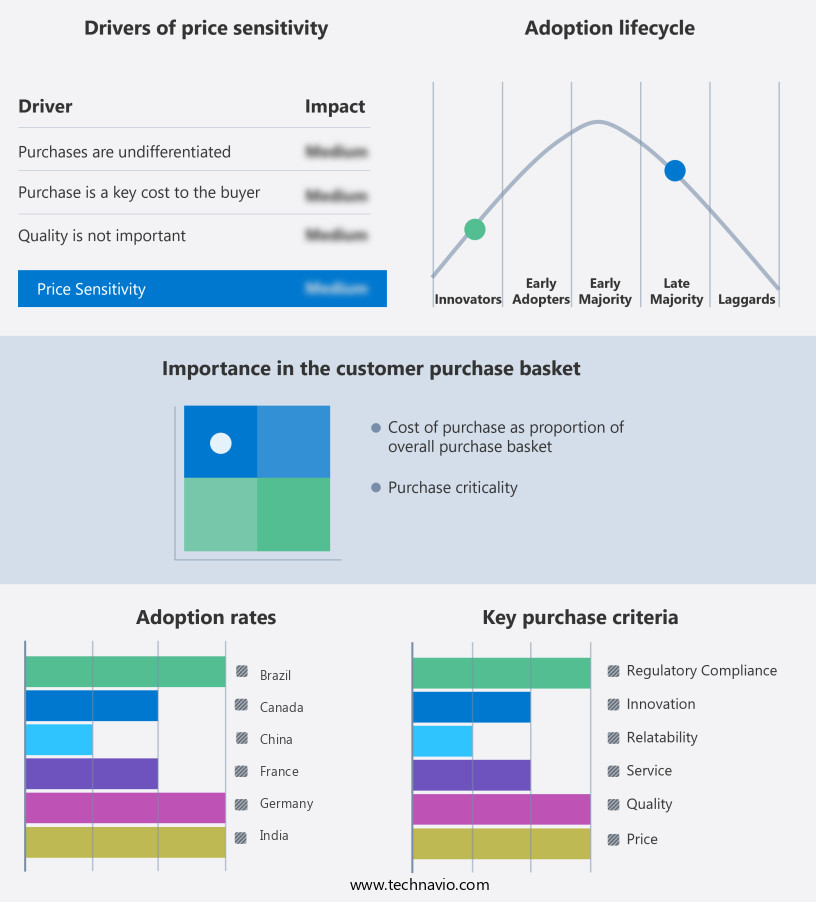
Customer Landscape of Deepfake AI Industry
Competitive Landscape
Companies are implementing various strategies, such as strategic alliances, deepfake ai market forecast, partnerships, mergers and acquisitions, geographical expansion, and product/service launches, to enhance their presence in the industry.
Colossyan Inc - This company provides a cutting-edge AI video creation platform, specialized in workplace learning and development. It simplifies the process of updating training materials through video content.
The industry research and growth report includes detailed analyses of the competitive landscape of the market and information about key companies, including:
- Colossyan Inc
- DeepBrain AI.
- Descript
- De Identification Ltd.
- Eleven Labs Inc.
- Flawless
- Google LLC
- HeyGen
- Hour One AI
- invideo
- Meta Platforms Inc.
- Microsoft Corp.
- Pika
- Reality Defender Inc.
- Reface
- Runway AI Inc.
- Synthesia Ltd.
- Truepic
- Veritone Inc.
Qualitative and quantitative analysis of companies has been conducted to help clients understand the wider business environment as well as the strengths and weaknesses of key industry players. Data is qualitatively analyzed to categorize companies as pure play, category-focused, industry-focused, and diversified; it is quantitatively analyzed to categorize companies as dominant, leading, strong, tentative, and weak.
Recent Development and News in Deepfake AI Market
- In January 2024, tech giant Microsoft announced the integration of deepfake detection technology into its Azure Cognitive Services platform (Microsoft Press Release). This development aimed to help businesses and content creators combat the spread of deepfake media.
- In March 2024, IBM and Adobe partnered to create a Deepfake Detection Consortium, bringing together leading experts in technology, media, and academia to develop open standards for detecting and mitigating deepfakes (IBM Press Release).
- In May 2024, synthetic media company Synthesia raised USD100 million in a Series C funding round, with plans to expand its deepfake technology offerings and enter new markets (TechCrunch).
- In February 2025, the European Union passed the Deepfake Regulation Act, imposing strict penalties for creating and distributing deepfake media without consent (EU Parliament Press Release). This legislation marked a significant step towards regulating the use of deepfake technology.
Dive into Technavio's robust research methodology, blending expert interviews, extensive data synthesis, and validated models for unparalleled Deepfake AI Market insights. See full methodology.
|
Market Scope
|
|
Report Coverage
|
Details
|
|
Page number
|
245
|
|
Base year
|
2024
|
|
Historic period
|
2019-2023 |
|
Forecast period
|
2025-2029
|
|
Growth momentum & CAGR
|
Accelerate at a CAGR of 40.8%
|
|
Market growth 2025-2029
|
USD 3238.1 million
|
|
Market structure
|
Fragmented
|
|
YoY growth 2024-2025(%)
|
38.4
|
|
Key countries
|
US, China, Germany, India, Canada, UK, France, Japan, Brazil, and South Korea
|
|
Competitive landscape
|
Leading Companies, Market Positioning of Companies, Competitive Strategies, and Industry Risks
|
Request Free Sample
Research Analyst Overview
- The market continues to evolve, driven by advancements in synthetic media detection and blockchain-based verification technologies. These innovations aim to mitigate the impact of AI-generated content detection and misinformation campaigns. Convolutional neural networks and temporal consistency analysis are at the forefront of deepfake detection software development. Data augmentation strategies and audio synthesis methods are also being explored to enhance the accuracy of these solutions. Computer vision applications, such as facial recognition technology and biometric authentication systems, are increasingly being targeted by deepfake creators. As a result, the need for forgery detection algorithms and video manipulation technique analysis is growing.
- Image quality assessment and statistical analysis methods are essential tools for media forensics techniques, which are crucial in identifying and mitigating the spread of deepfakes. Deep learning models and anomaly detection systems are being employed for real-time deepfake detection. Natural language processing and pattern recognition techniques are also being used to detect AI-generated text. Liveness detection systems and neural network architectures are being explored to improve the accuracy of deepfake detection. Despite these advancements, artificial intelligence ethics and data privacy concerns remain significant challenges. The market is expected to grow by over 20% annually, as the ongoing unfolding of market activities and evolving patterns continue to shape the landscape.
- For instance, a recent study revealed a 45% increase in deepfake videos on social media platforms in the last quarter. These trends underscore the importance of continued innovation and investment in deepfake detection technologies.
What are the Key Data Covered in this Deepfake AI Market Research and Growth Report?
-
What is the expected growth of the Deepfake AI Market between 2025 and 2029?
-
What segmentation does the market report cover?
-
The report is segmented by Deployment (Cloud and On premises), Technology (GANs, Transformer models, Autoencoders, Recurrent neural networks, and Others), End-user (Media and production studios, Enterprises and corporates, Defense and intelligence agencies, Education providers, and Others), and Geography (North America, APAC, Europe, South America, and Middle East and Africa)
-
Which regions are analyzed in the report?
-
North America, APAC, Europe, South America, and Middle East and Africa
-
What are the key growth drivers and market challenges?
-
Who are the major players in the Deepfake AI Market?
-
Colossyan Inc, DeepBrain AI., Descript, De Identification Ltd., Eleven Labs Inc., Flawless, Google LLC, HeyGen, Hour One AI, invideo, Meta Platforms Inc., Microsoft Corp., Pika, Reality Defender Inc., Reface, Runway AI Inc., Synthesia Ltd., Truepic, and Veritone Inc.
Market Research Insights
- The market for deepfake AI technologies is a continually advancing field, with ongoing research and development leading to new applications and capabilities. Two significant data points illustrate its growth and dynamic nature. First, the number of deepfake video views on social media platforms has increased by over 1,000% year-over-year. Second, industry experts anticipate that the deepfake market will expand at a rate of 45% annually over the next five years. Deepfake AI technologies offer various applications, including data security measures, mitigation technologies, and social impact assessment. For instance, a leading entertainment company reported a 25% increase in engagement rates after using deepfake AI to create personalized video messages for its subscribers.
- Meanwhile, the challenges of detecting and countering deepfakes remain a pressing concern, with real-time processing and data preprocessing methods being critical areas of focus. The deepfake market encompasses a diverse range of technologies and approaches, including edge computing solutions, performance benchmarks, ethical considerations, and model accuracy metrics. Companies are investing in deep learning frameworks, neural network optimization, and software development lifecycle methodologies to develop and deploy these solutions. Additionally, privacy-preserving techniques, content moderation tools, and public awareness campaigns are essential components of the deepfake ecosystem. As the deepfake market continues to evolve, it presents both opportunities and challenges.
- Continuous innovation is necessary to address detection challenges, ethical considerations, and scalability issues. Furthermore, collaboration between industry, academia, and regulatory bodies is crucial to ensure that deepfake technologies are used responsibly and ethically.
We can help! Our analysts can customize this deepfake AI market research report to meet your requirements.
Get in touch
1 Executive Summary
- 1.1 Market overview
- Executive Summary - Chart on Market Overview
- Executive Summary - Data Table on Market Overview
- Executive Summary - Chart on Global Market Characteristics
- Executive Summary - Chart on Market by Geography
- Executive Summary - Chart on Market Segmentation by Deployment
- Executive Summary - Chart on Market Segmentation by Technology
- Executive Summary - Chart on Market Segmentation by End-user
- Executive Summary - Chart on Incremental Growth
- Executive Summary - Data Table on Incremental Growth
- Executive Summary - Chart on Company Market Positioning
2 Technavio Analysis
- 2.1 Analysis of price sensitivity, lifecycle, customer purchase basket, adoption rates, and purchase criteria
- Analysis of price sensitivity, lifecycle, customer purchase basket, adoption rates, and purchase criteria
- 2.2 Criticality of inputs and Factors of differentiation
- Overview on criticality of inputs and factors of differentiation
- 2.3 Factors of disruption
- Overview on factors of disruption
- 2.4 Impact of drivers and challenges
- Impact of drivers and challenges in 2024 and 2029
3 Market Landscape
- 3.1 Market ecosystem
- Parent Market
- Data Table on - Parent Market
- 3.2 Market characteristics
- Market characteristics analysis
4 Market Sizing
- 4.1 Market definition
- Offerings of companies included in the market definition
- 4.2 Market segment analysis
- 4.4 Market outlook: Forecast for 2024-2029
- Chart on Global - Market size and forecast 2024-2029 ($ million)
- Data Table on Global - Market size and forecast 2024-2029 ($ million)
- Chart on Global Market: Year-over-year growth 2024-2029 (%)
- Data Table on Global Market: Year-over-year growth 2024-2029 (%)
5 Historic Market Size
- 5.1 Global Deepfake AI Market 2019 - 2023
- Historic Market Size - Data Table on Global Deepfake AI Market 2019 - 2023 ($ million)
- 5.2 Deployment segment analysis 2019 - 2023
- Historic Market Size - Deployment Segment 2019 - 2023 ($ million)
- 5.3 Technology segment analysis 2019 - 2023
- Historic Market Size - Technology Segment 2019 - 2023 ($ million)
- 5.4 End-user segment analysis 2019 - 2023
- Historic Market Size - End-user Segment 2019 - 2023 ($ million)
- 5.5 Geography segment analysis 2019 - 2023
- Historic Market Size - Geography Segment 2019 - 2023 ($ million)
- 5.6 Country segment analysis 2019 - 2023
- Historic Market Size - Country Segment 2019 - 2023 ($ million)
6 Five Forces Analysis
- 6.1 Five forces summary
- Five forces analysis - Comparison between 2024 and 2029
- 6.2 Bargaining power of buyers
- Bargaining power of buyers - Impact of key factors 2024 and 2029
- 6.3 Bargaining power of suppliers
- Bargaining power of suppliers - Impact of key factors in 2024 and 2029
- 6.4 Threat of new entrants
- Threat of new entrants - Impact of key factors in 2024 and 2029
- 6.5 Threat of substitutes
- Threat of substitutes - Impact of key factors in 2024 and 2029
- 6.6 Threat of rivalry
- Threat of rivalry - Impact of key factors in 2024 and 2029
- 6.7 Market condition
- Chart on Market condition - Five forces 2024 and 2029
7 Market Segmentation by Deployment
- 7.1 Market segments
- Chart on Deployment - Market share 2024-2029 (%)
- Data Table on Deployment - Market share 2024-2029 (%)
- 7.2 Comparison by Deployment
- Chart on Comparison by Deployment
- Data Table on Comparison by Deployment
- 7.3 Cloud - Market size and forecast 2024-2029
- Chart on Cloud - Market size and forecast 2024-2029 ($ million)
- Data Table on Cloud - Market size and forecast 2024-2029 ($ million)
- Chart on Cloud - Year-over-year growth 2024-2029 (%)
- Data Table on Cloud - Year-over-year growth 2024-2029 (%)
- 7.4 On premises - Market size and forecast 2024-2029
- Chart on On premises - Market size and forecast 2024-2029 ($ million)
- Data Table on On premises - Market size and forecast 2024-2029 ($ million)
- Chart on On premises - Year-over-year growth 2024-2029 (%)
- Data Table on On premises - Year-over-year growth 2024-2029 (%)
- 7.5 Market opportunity by Deployment
- Market opportunity by Deployment ($ million)
- Data Table on Market opportunity by Deployment ($ million)
8 Market Segmentation by Technology
- 8.1 Market segments
- Chart on Technology - Market share 2024-2029 (%)
- Data Table on Technology - Market share 2024-2029 (%)
- 8.2 Comparison by Technology
- Chart on Comparison by Technology
- Data Table on Comparison by Technology
- 8.3 GANs - Market size and forecast 2024-2029
- Chart on GANs - Market size and forecast 2024-2029 ($ million)
- Data Table on GANs - Market size and forecast 2024-2029 ($ million)
- Chart on GANs - Year-over-year growth 2024-2029 (%)
- Data Table on GANs - Year-over-year growth 2024-2029 (%)
- 8.4 Transformer models - Market size and forecast 2024-2029
- Chart on Transformer models - Market size and forecast 2024-2029 ($ million)
- Data Table on Transformer models - Market size and forecast 2024-2029 ($ million)
- Chart on Transformer models - Year-over-year growth 2024-2029 (%)
- Data Table on Transformer models - Year-over-year growth 2024-2029 (%)
- 8.5 Autoencoders - Market size and forecast 2024-2029
- Chart on Autoencoders - Market size and forecast 2024-2029 ($ million)
- Data Table on Autoencoders - Market size and forecast 2024-2029 ($ million)
- Chart on Autoencoders - Year-over-year growth 2024-2029 (%)
- Data Table on Autoencoders - Year-over-year growth 2024-2029 (%)
- 8.6 Recurrent neural networks - Market size and forecast 2024-2029
- Chart on Recurrent neural networks - Market size and forecast 2024-2029 ($ million)
- Data Table on Recurrent neural networks - Market size and forecast 2024-2029 ($ million)
- Chart on Recurrent neural networks - Year-over-year growth 2024-2029 (%)
- Data Table on Recurrent neural networks - Year-over-year growth 2024-2029 (%)
- 8.7 Others - Market size and forecast 2024-2029
- Chart on Others - Market size and forecast 2024-2029 ($ million)
- Data Table on Others - Market size and forecast 2024-2029 ($ million)
- Chart on Others - Year-over-year growth 2024-2029 (%)
- Data Table on Others - Year-over-year growth 2024-2029 (%)
- 8.8 Market opportunity by Technology
- Market opportunity by Technology ($ million)
- Data Table on Market opportunity by Technology ($ million)
9 Market Segmentation by End-user
- 9.1 Market segments
- Chart on End-user - Market share 2024-2029 (%)
- Data Table on End-user - Market share 2024-2029 (%)
- 9.2 Comparison by End-user
- Chart on Comparison by End-user
- Data Table on Comparison by End-user
- 9.3 Media and production studios - Market size and forecast 2024-2029
- Chart on Media and production studios - Market size and forecast 2024-2029 ($ million)
- Data Table on Media and production studios - Market size and forecast 2024-2029 ($ million)
- Chart on Media and production studios - Year-over-year growth 2024-2029 (%)
- Data Table on Media and production studios - Year-over-year growth 2024-2029 (%)
- 9.4 Enterprises and corporates - Market size and forecast 2024-2029
- Chart on Enterprises and corporates - Market size and forecast 2024-2029 ($ million)
- Data Table on Enterprises and corporates - Market size and forecast 2024-2029 ($ million)
- Chart on Enterprises and corporates - Year-over-year growth 2024-2029 (%)
- Data Table on Enterprises and corporates - Year-over-year growth 2024-2029 (%)
- 9.5 Defense and intelligence agencies - Market size and forecast 2024-2029
- Chart on Defense and intelligence agencies - Market size and forecast 2024-2029 ($ million)
- Data Table on Defense and intelligence agencies - Market size and forecast 2024-2029 ($ million)
- Chart on Defense and intelligence agencies - Year-over-year growth 2024-2029 (%)
- Data Table on Defense and intelligence agencies - Year-over-year growth 2024-2029 (%)
- 9.6 Education providers - Market size and forecast 2024-2029
- Chart on Education providers - Market size and forecast 2024-2029 ($ million)
- Data Table on Education providers - Market size and forecast 2024-2029 ($ million)
- Chart on Education providers - Year-over-year growth 2024-2029 (%)
- Data Table on Education providers - Year-over-year growth 2024-2029 (%)
- 9.7 Others - Market size and forecast 2024-2029
- Chart on Others - Market size and forecast 2024-2029 ($ million)
- Data Table on Others - Market size and forecast 2024-2029 ($ million)
- Chart on Others - Year-over-year growth 2024-2029 (%)
- Data Table on Others - Year-over-year growth 2024-2029 (%)
- 9.8 Market opportunity by End-user
- Market opportunity by End-user ($ million)
- Data Table on Market opportunity by End-user ($ million)
10 Customer Landscape
- 10.1 Customer landscape overview
- Analysis of price sensitivity, lifecycle, customer purchase basket, adoption rates, and purchase criteria
11 Geographic Landscape
- 11.1 Geographic segmentation
- Chart on Market share by geography 2024-2029 (%)
- Data Table on Market share by geography 2024-2029 (%)
- 11.2 Geographic comparison
- Chart on Geographic comparison
- Data Table on Geographic comparison
- 11.3 North America - Market size and forecast 2024-2029
- Chart on North America - Market size and forecast 2024-2029 ($ million)
- Data Table on North America - Market size and forecast 2024-2029 ($ million)
- Chart on North America - Year-over-year growth 2024-2029 (%)
- Data Table on North America - Year-over-year growth 2024-2029 (%)
- 11.4 APAC - Market size and forecast 2024-2029
- Chart on APAC - Market size and forecast 2024-2029 ($ million)
- Data Table on APAC - Market size and forecast 2024-2029 ($ million)
- Chart on APAC - Year-over-year growth 2024-2029 (%)
- Data Table on APAC - Year-over-year growth 2024-2029 (%)
- 11.5 Europe - Market size and forecast 2024-2029
- Chart on Europe - Market size and forecast 2024-2029 ($ million)
- Data Table on Europe - Market size and forecast 2024-2029 ($ million)
- Chart on Europe - Year-over-year growth 2024-2029 (%)
- Data Table on Europe - Year-over-year growth 2024-2029 (%)
- 11.6 South America - Market size and forecast 2024-2029
- Chart on South America - Market size and forecast 2024-2029 ($ million)
- Data Table on South America - Market size and forecast 2024-2029 ($ million)
- Chart on South America - Year-over-year growth 2024-2029 (%)
- Data Table on South America - Year-over-year growth 2024-2029 (%)
- 11.7 Middle East and Africa - Market size and forecast 2024-2029
- Chart on Middle East and Africa - Market size and forecast 2024-2029 ($ million)
- Data Table on Middle East and Africa - Market size and forecast 2024-2029 ($ million)
- Chart on Middle East and Africa - Year-over-year growth 2024-2029 (%)
- Data Table on Middle East and Africa - Year-over-year growth 2024-2029 (%)
- 11.8 US - Market size and forecast 2024-2029
- Chart on US - Market size and forecast 2024-2029 ($ million)
- Data Table on US - Market size and forecast 2024-2029 ($ million)
- Chart on US - Year-over-year growth 2024-2029 (%)
- Data Table on US - Year-over-year growth 2024-2029 (%)
- 11.9 China - Market size and forecast 2024-2029
- Chart on China - Market size and forecast 2024-2029 ($ million)
- Data Table on China - Market size and forecast 2024-2029 ($ million)
- Chart on China - Year-over-year growth 2024-2029 (%)
- Data Table on China - Year-over-year growth 2024-2029 (%)
- 11.10 Germany - Market size and forecast 2024-2029
- Chart on Germany - Market size and forecast 2024-2029 ($ million)
- Data Table on Germany - Market size and forecast 2024-2029 ($ million)
- Chart on Germany - Year-over-year growth 2024-2029 (%)
- Data Table on Germany - Year-over-year growth 2024-2029 (%)
- 11.11 India - Market size and forecast 2024-2029
- Chart on India - Market size and forecast 2024-2029 ($ million)
- Data Table on India - Market size and forecast 2024-2029 ($ million)
- Chart on India - Year-over-year growth 2024-2029 (%)
- Data Table on India - Year-over-year growth 2024-2029 (%)
- 11.12 UK - Market size and forecast 2024-2029
- Chart on UK - Market size and forecast 2024-2029 ($ million)
- Data Table on UK - Market size and forecast 2024-2029 ($ million)
- Chart on UK - Year-over-year growth 2024-2029 (%)
- Data Table on UK - Year-over-year growth 2024-2029 (%)
- 11.13 Canada - Market size and forecast 2024-2029
- Chart on Canada - Market size and forecast 2024-2029 ($ million)
- Data Table on Canada - Market size and forecast 2024-2029 ($ million)
- Chart on Canada - Year-over-year growth 2024-2029 (%)
- Data Table on Canada - Year-over-year growth 2024-2029 (%)
- 11.14 France - Market size and forecast 2024-2029
- Chart on France - Market size and forecast 2024-2029 ($ million)
- Data Table on France - Market size and forecast 2024-2029 ($ million)
- Chart on France - Year-over-year growth 2024-2029 (%)
- Data Table on France - Year-over-year growth 2024-2029 (%)
- 11.15 Japan - Market size and forecast 2024-2029
- Chart on Japan - Market size and forecast 2024-2029 ($ million)
- Data Table on Japan - Market size and forecast 2024-2029 ($ million)
- Chart on Japan - Year-over-year growth 2024-2029 (%)
- Data Table on Japan - Year-over-year growth 2024-2029 (%)
- 11.16 Brazil - Market size and forecast 2024-2029
- Chart on Brazil - Market size and forecast 2024-2029 ($ million)
- Data Table on Brazil - Market size and forecast 2024-2029 ($ million)
- Chart on Brazil - Year-over-year growth 2024-2029 (%)
- Data Table on Brazil - Year-over-year growth 2024-2029 (%)
- 11.17 South Korea - Market size and forecast 2024-2029
- Chart on South Korea - Market size and forecast 2024-2029 ($ million)
- Data Table on South Korea - Market size and forecast 2024-2029 ($ million)
- Chart on South Korea - Year-over-year growth 2024-2029 (%)
- Data Table on South Korea - Year-over-year growth 2024-2029 (%)
- 11.18 Market opportunity by geography
- Market opportunity by geography ($ million)
- Data Tables on Market opportunity by geography ($ million)
12 Drivers, Challenges, and Opportunity/Restraints
- 12.3 Impact of drivers and challenges
- Impact of drivers and challenges in 2024 and 2029
- 12.4 Market opportunities/restraints
13 Competitive Landscape
- 13.2 Competitive Landscape
- Overview on criticality of inputs and factors of differentiation
- 13.3 Landscape disruption
- Overview on factors of disruption
- 13.4 Industry risks
- Impact of key risks on business
14 Competitive Analysis
- 14.2 Company ranking index
- 14.3 Market positioning of companies
- Matrix on companies position and classification
- 14.4 Colossyan Inc
- Colossyan Inc - Overview
- Colossyan Inc - Product / Service
- Colossyan Inc - Key offerings
- SWOT
- 14.5 DeepBrain AI.
- DeepBrain AI. - Overview
- DeepBrain AI. - Product / Service
- DeepBrain AI. - Key offerings
- SWOT
- 14.6 Descript
- Descript - Overview
- Descript - Product / Service
- Descript - Key offerings
- SWOT
- 14.7 De Identification Ltd.
- De Identification Ltd. - Overview
- De Identification Ltd. - Product / Service
- De Identification Ltd. - Key offerings
- SWOT
- 14.8 Eleven Labs Inc.
- Eleven Labs Inc. - Overview
- Eleven Labs Inc. - Product / Service
- Eleven Labs Inc. - Key offerings
- SWOT
- 14.9 Google LLC
- Google LLC - Overview
- Google LLC - Product / Service
- Google LLC - Key offerings
- SWOT
- 14.10 HeyGen
- HeyGen - Overview
- HeyGen - Product / Service
- HeyGen - Key offerings
- SWOT
- 14.11 Hour One AI
- Hour One AI - Overview
- Hour One AI - Product / Service
- Hour One AI - Key offerings
- SWOT
- 14.12 invideo
- invideo - Overview
- invideo - Product / Service
- invideo - Key offerings
- SWOT
- 14.13 Meta Platforms Inc.
- Meta Platforms Inc. - Overview
- Meta Platforms Inc. - Business segments
- Meta Platforms Inc. - Key offerings
- Meta Platforms Inc. - Segment focus
- SWOT
- 14.14 Microsoft Corp.
- Microsoft Corp. - Overview
- Microsoft Corp. - Business segments
- Microsoft Corp. - Key news
- Microsoft Corp. - Key offerings
- Microsoft Corp. - Segment focus
- SWOT
- 14.15 Pika
- Pika - Overview
- Pika - Product / Service
- Pika - Key offerings
- SWOT
- 14.16 Runway AI Inc.
- Runway AI Inc. - Overview
- Runway AI Inc. - Product / Service
- Runway AI Inc. - Key offerings
- SWOT
- 14.17 Synthesia Ltd.
- Synthesia Ltd. - Overview
- Synthesia Ltd. - Product / Service
- Synthesia Ltd. - Key offerings
- SWOT
- 14.18 Veritone Inc.
- Veritone Inc. - Overview
- Veritone Inc. - Product / Service
- Veritone Inc. - Key offerings
- SWOT
15 Appendix
- 15.2 Inclusions and exclusions checklist
- Inclusions checklist
- Exclusions checklist
- 15.3 Currency conversion rates for US$
- Currency conversion rates for US$
- 15.4 Research methodology
- 15.7 Validation techniques employed for market sizing
- Validation techniques employed for market sizing
- 15.9 360 degree market analysis
- 360 degree market analysis
- 15.10 List of abbreviations







![]() Get the report (PDF) sent to your email within minutes.
Get the report (PDF) sent to your email within minutes.
Complimentary full Excel data with your report purchase.